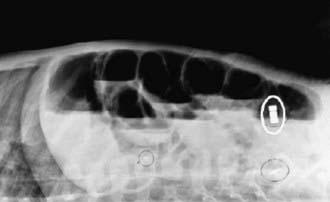Chapter 326 Foreign Bodies and Bezoars
326.1 Foreign Bodies in the Stomach and Intestine
Once in the stomach, 95% of all ingested objects pass without difficulty through the remainder of the gastrointestinal tract. Perforation after ingestion of a foreign body is estimated to be <1% of all objects ingested. Perforation tends to occur in areas of physiologic sphincters (pylorus, ileocecal valve), acute angulation (duodenal sweep), congenital gut malformations (webs, diaphragms, diverticula), or areas of previous bowel surgery.
Most patients who ingest foreign bodies are between the ages of 6 mo and 6 yr. Coins are the most commonly ingested foreign body in children, and meat or food impactions are the most common accidental foreign body in adolescents and adults. Patients with nonfood foreign bodies often describe a history of ingestion. Young children might have a witness to ingestion. Approximately 90% of foreign bodies are opaque. Radiologic examination is routinely performed to determine the type, number, and location of the suspected objects. Contrast radiographs may be necessary to demonstrate some objects, such as plastic parts or toys.
Conservative management is indicated for most foreign bodies that have passed through the esophagus and entered the stomach. Most objects pass though the intestine in 4-6 days, although some take as long as 3-4 wk. While waiting for the object to pass, parents are instructed to continue a regular diet and to observe the stools for the appearance of the ingested object. Cathartics should be avoided. Exceptionally long or sharp objects are usually monitored radiologically. Parents or patients should be instructed to report abdominal pain, vomiting, persistent fever, and hematemesis or melena immediately to their physicians. Failure of the object to progress within 3-4 wk seldom implies an impeding perforation but may be associated with a congenital malformation or acquired bowel abnormality.
Certain objects pose more risk than others. In cases of sharp foreign bodies, such as straight pins, weekly assessments are required. Surgical removal is necessary if the patient develops symptoms or signs of obstruction or perforation or if the foreign body fails to progress for several weeks. Small magnets used to secure earrings have been associated with bowel perforation. When the multiple magnets disperse after ingestion, they may be attracted to each other across bowel wall, leading to pressure necrosis and perforation (Fig. 326-1). Inexpensive toy medallions containing lead can lead to lead toxicity. Newer coins can also decompose when subjected to prolonged acid exposure. Unless multiple coins are ingested; however, the metals released are unlikely to pose a clinical risk.

Figure 326-1 Abdominal radiograph of a boy aged 3 yr, noting 3 attached magnets that resulted in volvulus (i.e., twisting of the bowel) and multiple bowel perforations.
(Courtesy of the US Consumer Product Safety Commission. From Centers for Disease Control and Prevention: Gastrointestinal injuries from magnet ingestion in children—United States, 2003–2006, MMWR 55:1296–1300, 2006.)
Stay updated, free articles. Join our Telegram channel

Full access? Get Clinical Tree


